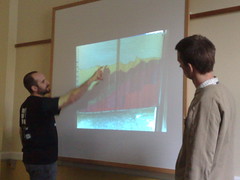Matt Wynne & Rob Bowley, Evolving from Scrum to LEAN
 Matt Wynne & Rob Bowley, Evolving from Scrum to LEAN
Matt Wynne & Rob Bowley, Evolving from Scrum to LEAN
Worked together at BBC Worldwide. Took a well-functioning Scrum team and improved it.
You need an enlightened organisation to do this: "it is possible to divide the work into small value-adding increments that can be independently scheduled" and an enlightened team where "it is possible to develop any value-added increment in a continuous flow from requirement to deployment".
Colocated team of 12, 2 year project.
Scrum was a success story for them. They were first team in BBC Worldwide to do agile; now there isn't a team there that doesn't do some sort of agile.
One key concept from lean is "eliminating waste". Where is time, money, resource, going needlessly? How do you optimise? They saw spending an afternoon predicting lengths of 1-4h tasks to be intensive, tiring, and frequently they found that in week 2 of the sprint their understanding of the tasks had changed. Their estimates weren't reliable, and the session is intense.
One lean concept: "value stream mapping".
They realised their definition of done was wrong. Things were going into tests but not getting tested in-sprint. Velocity had been increasing and suddenly flattened as they had to fix all the bugs. They realised they were missing a better visual representation of the flow: they added stages to their process.
One morning they decided to stop iterating, abandon task cards and burndowns. They started using a kanban board, with tokens representing single user stories. Team process is represented as a series of stages, from concept through to production code: customer desires, analysis, development, testing, awaiting deployment, deployed. Large numbers of tokens in any one stage show where blockages lie.
To replace burndown, team records daily where stories are in this process, on a colour chart. This gives a clear idea of where bottlenecks are in the process: e.g. system testing was at one point overloading the poor tester; too much work-in-progress shown visually told them they needed to limit amount of WIP.
Another lean concept: "stop the line".
The whole team could see the state of the project and cared about it. Continuous integration is a classic example of this: the build breaks and it's fixed immediately.
The after-effects: the team became more disciplined. They'd record checklists of things to keep an eye on from retrospectives. Became more flexible; there's an overhead to working in iterations when it comes to preparing for work. They weren't able to stop sprints when requirements changed previously - is anyone? The product owner was more empowered, she could rearrange priorities at will.
The downside: we miss the rhythm of the iteration and getting everyone around a set of goals. We became disconnected from one another. At Songkick (Matt's new job) they're seeing rhythm elsewhere: in show and tells, in the rate work comes off the production line, etc.
Conclusions: smaller is better, flow beats batch. It takes time to change; it was only in the last 3 months of the project that we reached this level of efficiency. Don't try and do everything at once. Lean/Kanban is not a new religion; be as reflective as possible in your team and organisations.
Question: without estimation, how did you give meaningful assurances of when the overall project would be done?
Answer: the chart gave us velocity for individual stages of stories, so we could extrapolate from that. They stopped estimating tasks, but kept estimating stories.
Question: how would this apply to a product development environment where you want features batched into a release?
Answer: OSS projects release an edge version every day and stable release more often: it's the same here.